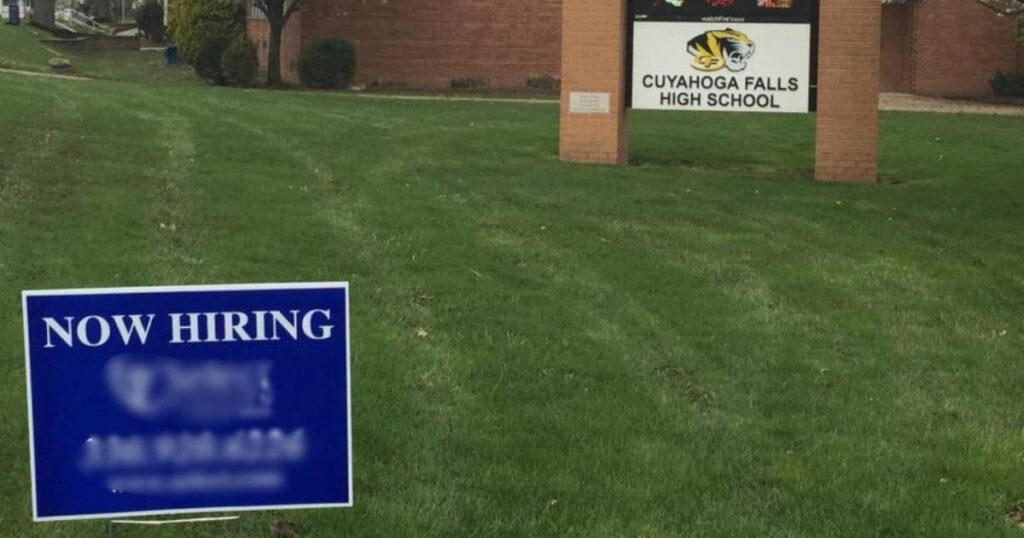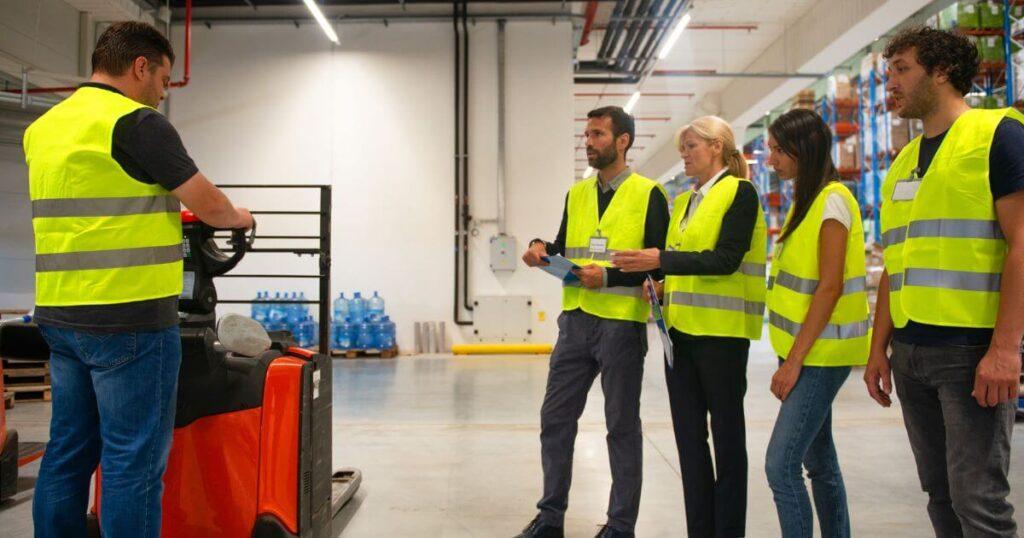Digital transformation has not only impacted the manufacturing industry, it’s also impacted the recruiting strategies used to attract new candidates.
There are many ways to recruit top talent. Some work. Some used to work. Some never worked.
Modern recruitment methods successfully blend innovative technology, creativity, and strong relationships to recruit employees effectively.
In a competitive job market that’s rife with challenges caused by skills gaps and changing workforce preferences, you want to make sure that your staffing partner embraces cutting-edge sourcing techniques.
Worst Recruiting Strategies For Manufacturing
If your industrial staffing partner use any of the following recruitment methods listed below, consider it a red flag.

Red Flag #1: NOW HIRING Signs All Over Town
Not long ago, one of our very own recruiters drove past a deeply disturbing sight: a (different) local staffing agency had planted multiple hiring signs front and center on a high school’s lawn.
The signs were placed on behalf of their client, who was one of the largest manufacturing facilities in the area.
The yard signs didn’t stop there, either. They seemed to be everywhere within a two block radius — the equivalent of old portrait paintings where the subject’s eyes seemed to follow you no matter where you were.
Memorable? Sure. But effective? Probably not.
While we understand the thought process (attracting soon-to-be high school grads who plan to enter the workforce instead of attending college), we can’t help but feel that it makes the agency look desperate.
Perhaps the client insisted on this outdated recruiting method so they had physical proof of the agency’s advertising efforts and wouldn’t take no for an answer.
Regardless, this is not an effective hiring tactic, nor should it be a major part of your staffing partner’s overall recruiting strategy. At best, the agency likely fielded phone calls from a few inexperienced 16-year-olds that they most likely can’t work anyway due to minor labor laws.
Green Flag: Digital Recruitment Strategies
Digital recruitment strategies like AI and social media platforms have become the new “lawn yard signs” for attracting talent.
Not only is it incredibly effective for reaching the right candidate audience, it’s efficient. The best manufacturing recruiters are able to target your ideal audience, connect with them just minutes after submitting their application (even if it’s at 2 AM), and place them on assignment within days.
In a candidate-driven market where they likely have multiple job options and/or offers, immediacy is key.

Red Flag #2: Onsite Job Fairs…All The Time
Let’s say your manufacturing facility is experiencing a major expansion and is forecasting a need to hire at least 20 people every month for the next year. Due to various factors, there likely won’t be much advance notice as to how many employees will be needed at any given time.
No big deal, right? This is what staffing agencies do best!
At your request, your staffing partner unveils their recruiting strategy: multiple onsite job fairs. Candidates will be drawn in with the chance to win cool prizes, maybe even get a free hot dog and soda.
Not only will candidates see where they could be working, they’ll even have the chance to be hired on the spot!
It will be advertised on social media, they’ll plant yard signs nearby, and invest in radio spots.
The first event resulted in a decent turnout, and a handful of applicants. The second event had fewer turnout, so the following event was held at a different time of day to accommodate people who were working. Each event resulted in fewer attendees, fewer applicants, only five total hires, and a very unhappy client.
Repeat after us: Being short-staffed is not something an onsite job fair on a sunny afternoon is going to fix.
If your agency repeatedly leans on these as part of their long-term strategy — especially without the supporting data to back it up — step back and ask them why.
Now, don’t get us wrong. There’s nothing wrong with job fairs, and there are times when job fairs make perfect sense. They can be a great way to get in front of the community for brand recognition and networking — from time to time.
But continuous in-person job fairs are typically not the best way to find the best employees., thanks to the logistical and financial implications that make it less efficient.
Green Flag: Occasional Recruitment Events
Virtual job fairs and online recruitment events — paired with an in person hiring event every now and then — are the new norm thanks to their efficiency and wider reach.
Whether it’s an Indeed Hiring Event or a virtual reality tour of a client’s manufacturing facility, virtual job fairs can be a more engaging and effective tactic in the recruiter’s tool belt.
However, your agency’s recruiting methods shouldn’t rely on a series of special events to attract candidates.
Like the manufacturing industry, recruiting should be a machine that is always running 24/7. If your staffing partner doesn’t have an always-on strategy for recruiting top talent, what are you even paying them for?

Red Flag #3: “Apply Today, Work Tomorrow”
Scroll through job boards and you’ll notice that a common phrase employers use is ‘start immediately!’. Come on, you might be thinking. What’s so bad about that? The right candidate can start working immediately!
Well, hear us out.
If you’re looking to fill short-term, non-skilled roles, this actually can be an effective recruiting tactic for the right audience. This typically attracts workers who:
- Don’t really know what they want to do for work
- Aren’t available for the long-term
- Have to take what they can get for the time being (usually until something better comes along)
However, it’s important to balance the need for immediate hires with the long term goal of finding committed and skilled workers.
Green Flag: Selective Sourcing
If your organization is investing considerable time and money into employee training and onboarding, you likely want candidates who are:
- Qualified and reliable
- Engaged in their work
- A culture fit
- Looking to stay and grow professionally
Good staffing agencies are consultative with their client companies and their candidates. They take the time to learn what each party is attempting to accomplish so they can connect the right talent with your organization when goals align.
A staffing partner with innovative recruiting strategies can attract hundreds of new candidates every week and always have their funnel full. Yet, it’s ok if their hiring process takes days or even weeks because they are focused on finding qualified talent.
This is especially true in the manufacturing industry where specific needs are required for skilled labor and technical roles.
There’s immense value in building a talent community and engaging potential candidates through meaningful interactions like content marketing, social media engagement, and personalized communication — long before the need to hire arises.

Red Flag #4: “Bring a Friend, Receive a Free Gift!”
You need to fill 20 positions, like, yesterday.
If your staffing partner’s hiring strategy is based on attracting 10 candidates and then bribing each of them to bring a friend for — oh I don’t know, a free lunch — then they should have no problem hitting that number. Right? Right?!
Spoiler alert: wrong. You might not even be shorthanded 20 people to begin with if your staffing agency used stronger recruiting strategies that focused on quality over quantity.
Green Flag: Intentional Employee Referral Programs
Rather than questionable quick fixes, your staffing partner should suggest referral programs that focus on quality candidates and long-term engagement (unless a quick fix is exactly what you’re looking for).
Tapping into existing relationships, leveraging employee networks, and offering thoughtful incentives can be powerful sourcing tools in recruitment.
You want your staffing partner to find more than just employees…you want them to find employees who are a good fit.

Red Flag #5: “Work Today, Paid Today”
We get it — immediate compensation for certain roles is pretty appealing from an employee’s point of view. But, what kind of employee?
Not only is this recruiting method a potential payroll and employment verification nightmare, it practically guarantees zero return on investment and never seeing that employee ever again once they have cash in hand.
Not to mention the effect this strategy has on company culture and employee engagement.
No matter your work setting — manufacturing and logistics or warehouse and distribution — you know that safety is paramount and training is crucial. Hiring someone who is just there for the instant cash at the end of the day seems like a giant safety risk, and your reputation is on the line.
Green Flag: Protecting Your Future Investment
Partner with a manufacturing staffing agency that emphasizes the importance of recruiting candidates who are interested in long-term growth and development, not one-hit-wonders.
These agencies will conduct thorough screening, background checks, employment verifications, and e-Verify — making your HR, safety, and payroll teams rejoice.
As manufacturing trends — such as automation, digitalization, and the need for a more skilled workforce — continue to evolve and reshape our industry, there’s a focus on sustainability and mutual growth between employers and employees.

Is Recruiting Getting Harder?
Recruiting isn’t getting harder. It just requires different types of recruitment than many are used to.
The manufacturing workforce is always changing, and so should your methods of recruitment. Hiring managers must evaluate and adapt their strategies continuously. Doing so will allow you to stay on top of industrial recruiting trends and incorporate them creatively into your hiring strategy in order to be successful.
If your staffing agency is stuck on ineffective or worn-out recruiting methods that may have worked decades ago (or never really worked at all), maybe it’s time to rethink not just your recruiting strategies, but your staffing partner.
After all, your company’s manufacturing processes operate with the most efficient methods available. Shouldn’t your staffing partner operate the same way?





